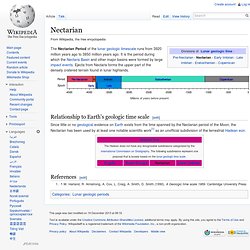

Lunar geologic timescale. The lunar geological timescale (or selenological timescale) divides the history of Earth's Moon into five generally recognized periods: the Copernican, Eratosthenian, Imbrian (Late and Early epochs), Nectarian, and Pre-Nectarian.

The boundaries of this time scale are related to large impact events that have modified the lunar surface, changes in crater form that occur through time, and the size-frequency distribution of craters superposed on geological units. The absolute ages for these periods have been constrained by radiometric dating of samples obtained from the lunar surface. However, there is still much debate concerning the ages of certain key events, because correlating lunar regolith samples with geological units on the Moon is difficult, and most lunar radiometric ages have been highly affected by an intense history of bombardment. Lunar stratigraphy[edit] Millions of years before present Pre-Nectarian[edit] Nectarian[edit] Imbrian[edit] Eratosthenian[edit] Copernican[edit] Pre-Nectarian. The Pre-Nectarian Period of the lunar geologic timescale runs from 4533 million years ago (the time of the initial formation of the Moon) to 3920 million years ago, when the Nectaris Basin was formed by a large impact.

It is followed by the Nectarian period. Pre-Nectarian rocks are rare in the lunar sample suite; they are mostly composed of lunar highlands material which have been heavily churned, brecciated, and thermally affected by subsequent impacts, particularly during the Late Heavy Bombardment that marks the approximate beginning of the Nectarian Period. The primary Pre-Nectarian lunar highland material is dominated by the rock type anorthosite, which suggests that the early stage of lunar crustal formation occurred via mineral crystallization of a global magma ocean. This geologic period has been informally subdivided into the Cryptic Era (4.533 - 4.172 Ga ago) and Basin Groups 1-9 (4.172 - 3.92 Ga ago),[1] but these divisions are not used on any geologic maps. References[edit] Late Heavy Bombardment. Evidence for the LHB event is primarily from dating lunar samples brought back by the Apollo astronauts, which (dates) imply that most impact melt rocks were formed in this rather narrow interval of time.
Several hypotheses are now offered to explain the spike in the flux of asteroids or comets in the inner Solar System but no consensus yet exists. The Nice model is popular among planetary scientists; it postulates that the gas giant planets underwent orbital migration and forced objects in the asteroid and/or Kuiper belts into eccentric orbits, and thereby into the path of the terrestrial planets.
Artist's impression of the moon during the Late Heavy Bombardment (Lunar Cataclysm) and today Evidence for a cataclysm[edit] The main piece of evidence for a lunar cataclysm comes from the radiometric ages of impact melt rocks that were collected during the Apollo missions. Under study on Earth, the ages of impact melts collected at these sites clustered between about 3.8 and 4.1 Ga.
Nectarian. The Nectarian Period of the lunar geologic timescale runs from 3920 million years ago to 3850 million years ago.

It is the period during which the Nectaris Basin and other major basins were formed by large impact events. Ejecta from Nectaris forms the upper part of the densely cratered terrain found in lunar highlands. Millions of years before present Relationship to Earth's geologic time scale[edit] References[edit] Jump up ^ W.